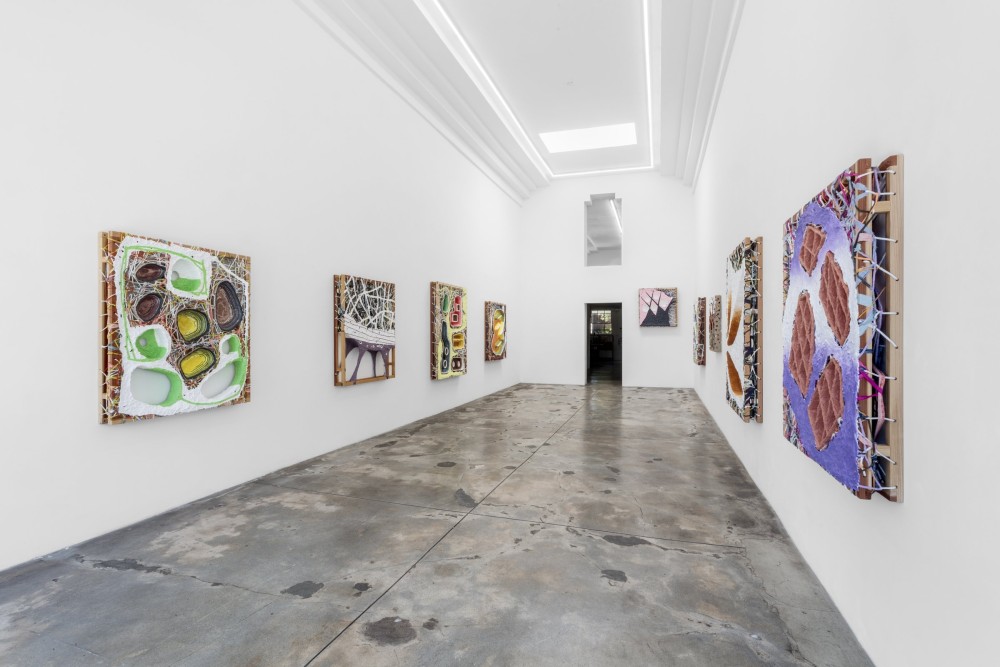
James Richards: Material Abstraction
Materials:
• Nylon String: 6 rolls (for weaving the canvas)
• Yarn: 4-6 bundles (varied colors for texture)
• Discarded Cloth: 6-10 pieces (for added texture and materiality)
• Cardboard: Several sheets (for structural elements)
• Papier-Mâché: Prepared from old newspapers and wheat paste (for vessels)
• Acrylic Paint: 8 quarts (assorted colors for painting)
• Polypropylene Rope: 4 piles (for structural reinforcement and texture)
• Chenille Yarn: 4 bundles (for added texture and surface detail)
• T-shirt Yarn: 3 balls (for additional texture)
• Macramé Cord: 7 piles (for weaving and structural elements)
• Pigmented Water: 4-6 gallons (prepared by mixing acrylic paint with water to create evaporation traces)
Optional Materials for Papier-Mâché Components:
• Cardboard Boxes: For forming vessels
• Tape: For assembling shapes
• Wire: For structural support
• Papier-Mâché Material: Homemade or store-bought
• Acrylic Paint: For coloring vessels
• Water: For mixing pigments
Instructions:
Create Structural Elements:
Stretcher Bars - Assemble using 2x2 redwood planks to create a double stretcher system, providing a 5-inch space for integrating compositional elements.
Cardboard Elements - Cut and shape cardboard for additional structural components. Optionally, use these elements to create space within the canvas.
Prepare the Canvas:
Weave the Base - Hand-weave the nylon string to create a textured base layer with openings.
Re-weave - Incorporate yarn and discarded cloth into the weave for added texture and visual interest.
Prepare Papier-Mâché Vessels:
Form Vessels - Cut the cardboard into desired shapes, using tape and wire for assembly. Ensure part of the vessel is convex to hold liquid.
Cover and Seal - Apply papier-mâché, let it dry, then seal with multiple layers of a titanium white and acrylic gel mixture for waterproofing. Pigmented Water - Mix acrylic paint with water, fill the vessels, and let them evaporate in the sun. The remaining pigment traces will add a unique texture.
Assemble and Integrate:
Integrate Vessels - Use ropes, strings, and cords to attach and suspend dried papier-mâché vessels within the woven canvas.
Layer with Textures - Add polypropylene rope, chenille, and t-shirt yarn for additional texture and structural complexity.
Weave Base Layer - Use all drilled holes to weave the base layer of polypropylene and nylon string. At this stage, incorporate any optional papier-mâché components.
Paint and Finish:
Apply Acrylic Paint - Use acrylic paint and a thick acrylic medium mixed with titanium white (50/50 ratio) to enhance and build texture on the surface.
Top Surface Paint - Add the final top layers of paint to complete the composition, creating additional compositional elements as desired.
Display:
Mount and Hang: Secure the finished artwork using double stretchers or another suitable method. Adjust the tension in ropes and strings to create a dynamic interplay between the picture plane and physical space.
Notes:
Materiality and Physicality: Emphasize the physical presence of the painting by exposing structural elements and integrating diverse textures.
Tension and Fluidity: Strive for a sense of tension and fluidity that reflects both flatness and the physicality of the materials.
Creation Process: Allow traces of evaporation and raw craftsmanship to be evident in the final piece, contributing to its narrative and visual complexity.
Influences: fossils, climate change, outer space, quantum physics, abstraction, arts and crafts, ant colonies, sculpture, macrame, cake frosting, land art, the built environment, sponges, urban/wildland interface, geology
About the Artist: Through James Richards’ use of materials—rope, yarn, paper, paint, wood—the abstract paintings take on qualities akin to instructive dioramas, enabling the viewer to understand and imagine concepts that oscillate from the tremendous to the quantum. An influential artist in the Los Angeles contemporary landscape, Richards has consistently exhibited his work in Southern California, New York, and Texas since graduating from Art Center College of Design, Pasadena, CA, with an MFA in 1991. His exhibitions have received praise and notoriety from critics such as David Pagel, Christopher Knight, and Ken Johnson in publications including The Los Angeles Times, The New York Times, Flash Art, and Art in America. Pagel has described James Richards’ works as “among the most exciting abstractions being made today.”